Use of Bacteria to Activate Ground-Granulated Blast-Furnace Slag (GGBFS) as Cementless Binder
Abstract
:1. Introduction
2. Materials and Methods
2.1. GGBFS
2.2. Bacteria
2.3. Sample Preparation
2.4. Compressive Strength
2.5. Mineralogy Identification
2.6. Pore Size Distribution
2.7. Water Absorption Rate
3. Results
3.1. Compressive Strength
3.2. Identifications of Associated Minerals
3.2.1. XRD
3.2.2. TG/DTG
3.3. Pore Size Distribution
3.4. Possibility of Commercializing Bacteria-Activated GGBFS
4. Conclusions
- A hypothesis was formed, wherein using bacteria and urea would hydrolyze urea and subsequently induce carbonate ions, which would consequently form calcite with calcium in GGBFS. However, the results indicated that the use of urea inhibited the strength improvement of bacteria-activated GGBFS. Hence, it was inferred that hydrated urea was not hydrolyzed because bacteria could not move freely to consume the urea within the GGBFS binder.
- Urea was hydrated but not ionized in the bacteria–GGBFS mixture. Hydrated urea occupied the pore space of the bacteria–GGBFS mixture, resulting in a higher porosity and lower strength compared with those of the sample without urea.
- The presence of bacterial suspension at a curing temperature of 23 °C was not conducive to the strength improvement of the GGBFS. However, incorporating bacterial suspension to the GGBFS at a curing temperature of 60 °C resulted in a higher strength as compared with one not incorporating bacterial suspension.
- The mineralogical identification of the bacteria-activated GGBFS indicated calcite formation as the primary contributor to the strength improvement.
- The strength of the bacteria-activated GGBFS was sufficient for the construction of bricks; however, the water absorption rate must be addressed for the successful commercialization of bacteria-activated GGBFS.
Author Contributions
Funding
Institutional Review Board Statement
Informed Consent Statement
Data Availability Statement
Conflicts of Interest
References
- Kerr, R.A. Global warming is changing the world. Science 2007, 316, 188–190. [Google Scholar] [CrossRef] [PubMed] [Green Version]
- Drake, F. Global Warming; Routledge: Oxfordshire, UK, 2014; pp. 1–273. [Google Scholar] [CrossRef]
- Mehta, P.; Monteiro, P. Concrete Microstructure, Properties and Materials; McGraw Hill Professional: Columbus, OH, USA, 2017. [Google Scholar]
- Poudyal, L.; Adhikari, K. Environmental sustainability in cement industry: An integrated approach for green and economical cement production. Resour. Environ. Sustain. 2021, 4, 100024. [Google Scholar] [CrossRef]
- Ighalo, J.O.; Adeniyi, A.G. A perspective on environmental sustainability in the cement industry. Waste Dispos. Sustain. Energy 2020, 2, 161–164. [Google Scholar] [CrossRef]
- Benhelal, E.; Shamsaei, E.; Rashid, M.I. Challenges against CO2 abatement strategies in cement industry: A review. J. Environ. Sci. 2021, 104, 84–101. [Google Scholar] [CrossRef]
- Do, T.M.; Kang, G.O.; Kim, Y. sang Development of a new cementless binder for controlled low strength material (CLSM) using entirely by-products. Constr. Build. Mater. 2019, 206, 576–589. [Google Scholar] [CrossRef]
- Yang, K.H.; Hwang, H.Z.; Kim, S.Y.; Song, J.K. Development of a cementless mortar using hwangtoh binder. Build. Environ. 2007, 42, 3717–3725. [Google Scholar] [CrossRef]
- Do, T.M.; Kang, G.; Vu, N.; Kim, Y. sang Development of a new cementless binder for marine dredged soil stabilization: Strength behavior, hydraulic resistance capacity, microstructural analysis, and environmental impact. Constr. Build. Mater. 2018, 186, 263–275. [Google Scholar] [CrossRef]
- Ameri, F.; Shoaei, P.; Bahrami, N.; Vaezi, M.; Ozbakkaloglu, T. Optimum rice husk ash content and bacterial concentration in self-compacting concrete. Constr. Build. Mater. 2019, 222, 796–813. [Google Scholar] [CrossRef]
- Poorveekan, K.; Ath, K.M.S.; Anburuvel, A.; Sathiparan, N. Investigation of the engineering properties of cementless stabilized earth blocks with alkali-activated eggshell and rice husk ash as a binder. Constr. Build. Mater. 2021, 277, 122371. [Google Scholar] [CrossRef]
- Lin, W.T. Development of cementless binder for low thermal conductivity materials: Reactive ultra-fine fly ash mixed with co-fired fly ash. Case Stud. Constr. Mater. 2022, 16, e00899. [Google Scholar] [CrossRef]
- Cheah, C.B.; Part, W.K.; Ramli, M. The long term engineering properties of cementless building block work containing large volume of wood ash and coal fly ash. Constr. Build. Mater. 2017, 143, 522–536. [Google Scholar] [CrossRef]
- Siddique, R.; Cachim, P. Waste and Supplementary Cementitious Materials in Concrete: Characterisation, Properties and Applications; Woodhead Publishing: Sawston, UK, 2018. [Google Scholar]
- Sanjuán, M.A.; Piñeiro, A.; Rodríguez, O. Ground granulated blast furnace slag efficiency coefficient (k value) in concrete. Applications and limits. Mater. Construcción 2011, 61, 303–313. [Google Scholar] [CrossRef] [Green Version]
- Aldea, C.M.; Young, F.; Wang, K.; Shah, S.P. Effects of curing conditions on properties of concrete using slag replacement. Cem. Concr. Res. 2000, 30, 465–472. [Google Scholar] [CrossRef]
- Yang, K.-H.; Song, J.-K. Workability Loss and Compressive Strength Development of Cementless Mortars Activated by Combination of Sodium Silicate and Sodium Hydroxide. J. Mater. Civ. Eng. 2009, 21, 119–127. [Google Scholar] [CrossRef]
- Bilim, C.; Karahan, O.; Atiş, C.D.; İlkentapar, S. Effects of chemical admixtures and curing conditions on some properties of alkali-activated cementless slag mixtures. KSCE J. Civ. Eng. 2015, 19, 733–741. [Google Scholar] [CrossRef]
- Ryu, G.S.; Lee, Y.B.; Koh, K.T.; Chung, Y.S. The mechanical properties of fly ash-based geopolymer concrete with alkaline activators. Constr. Build. Mater. 2013, 47, 409–418. [Google Scholar] [CrossRef]
- Xiao, R.; Jiang, X.; Zhang, M.; Polaczyk, P.; Huang, B. Analytical investigation of phase assemblages of alkali-activated materials in CaO-SiO2-Al2O3 systems: The management of reaction products and designing of precursors. Mater. Des. 2020, 194, 108975. [Google Scholar] [CrossRef]
- Asaad, M.A.; Huseien, G.F.; Memon, R.P.; Ghoshal, S.K.; Mohammadhosseini, H.; Alyousef, R. Enduring performance of alkali-activated mortars with metakaolin as granulated blast furnace slag replacement. Case Stud. Constr. Mater. 2022, 16, e00845. [Google Scholar] [CrossRef]
- Sultan, M.E.; Abo-El-Enein, S.A.; Sayed, A.Z.; EL-Sokkary, T.M.; Hammad, H.A. Incorporation of cement bypass flue dust in fly ash and blast furnace slag-based geopolymer. Case Stud. Constr. Mater. 2018, 8, 315–322. [Google Scholar] [CrossRef]
- Marvila, M.T.; de Azevedo, A.R.G.; de Oliveira, L.B.; de Castro Xavier, G.; Vieira, C.M.F. Mechanical, physical and durability properties of activated alkali cement based on blast furnace slag as a function of %Na2O. Case Stud. Constr. Mater. 2021, 15, e00723. [Google Scholar] [CrossRef]
- Bar-On, Y.M.; Phillips, R.; Milo, R. The biomass distribution on Earth. Proc. Natl. Acad. Sci. USA 2018, 115, 6506–6511. [Google Scholar] [CrossRef] [PubMed] [Green Version]
- Makul, N.; Fediuk, R.; Szelag, M. Advanced interactions of cement-based materials with microorganisms: A review and future perspective. J. Build. Eng. 2022, 45, 103458. [Google Scholar] [CrossRef]
- Achal, V.; Mukherjee, A.; Reddy, M.S. Microbial Concrete: Way to Enhance the Durability of Building Structures. J. Mater. Civ. Eng. 2010, 23, 730–734. [Google Scholar] [CrossRef] [Green Version]
- De Belie, N.; Gruyaert, E.; Al-Tabbaa, A.; Antonaci, P.; Baera, C.; Bajare, D.; Darquennes, A.; Davies, R.; Ferrara, L.; Jefferson, T.; et al. A Review of Self-Healing Concrete for Damage Management of Structures. Adv. Mater. Interfaces 2018, 5, 1800074. [Google Scholar] [CrossRef]
- Seifan, M.; Samani, A.K.; Berenjian, A. Bioconcrete: Next generation of self-healing concrete. Appl. Microbiol. Biotechnol. 2016, 100, 2591–2602. [Google Scholar] [CrossRef] [PubMed] [Green Version]
- Jonkers, H.M. Self Healing Concrete: A Biological Approach; Springer: Dordrecht, The Netherland, 2007; Volume 100. [Google Scholar]
- Talaiekhozani, A.; Abd Majid, M.Z. A review of self-healing concrete research development. J. Environ. Treat. Tech. 2014, 2, 1–11. [Google Scholar]
- Do, J.; Montoya, B.M.; Gabr, M.A. Debonding of Microbially Induced Carbonate Precipitation-Stabilized Sand by Shearing and Erosion. Geomech. Eng. Int. J. 2019, 17, 429–438. [Google Scholar] [CrossRef]
- ASTM D6913-17; Standard Test Methods for Particle-Size Distribution (Gradation) of Soils Using Sieve Analysis. ASTM: West Conshohocken, PA, USA, 2017.
- Belkly, A.; Helderman, M.; Karen, V.L.; Ulkch, P. New developments in the Inorganic Crystal Structure Database (ICSD): Accessibility in support of materials research and design. Acta Crystallogr. Sect. B Struct. Sci. 2002, 58, 364–369. [Google Scholar] [CrossRef] [Green Version]
- Ramachandran, S.K.; Ramakrishnan, V.; Bang, S.S. Remediation of Concrete Using Microorganisms. ACI Mater. J. 2001, 98, 3–9. [Google Scholar] [CrossRef]
- ASTM C305-14; Standard Practice for Mechanical Mixing of Hydraulic Cement Pastes and Mortars of Plastic Consistency. ASTM: West Conshohocken, PA, USA, 2014.
- Zhang, J.; Scherer, G.W. Comparison of methods for arresting hydration of cement. Cem. Concr. Res. 2011, 41, 1024–1036. [Google Scholar] [CrossRef]
- ASTM C109/C109M-02; Standard Test Method for Compressive Strength of Hydraulic Cement Mortars. ASTM: West Conshohocken, PA, USA, 2002.
- Yum, W.S.; Jeong, Y.; Yoon, S.; Jeon, D.; Jun, Y.; Oh, J.E. Effects of CaCl2 on hydration and properties of lime(CaO)-activated slag/fly ash binder. Cem. Concr. Compos. 2017, 84, 111–123. [Google Scholar] [CrossRef]
- Yum, W.S.; Jeong, Y.; Song, H.; Oh, J.E. Recycling of limestone fines using Ca(OH)2- and Ba(OH)2-activated slag systems for eco-friendly concrete brick production. Constr. Build. Mater. 2018, 185, 275–284. [Google Scholar] [CrossRef]
- Yum, W.S.; Suh, J.I.; Sim, S.; Yoon, S.; Jun, Y.; Oh, J.E. Influence of calcium and sodium nitrate on the strength and reaction products of the CaO-activated GGBFS system. Constr. Build. Mater. 2019, 215, 839–848. [Google Scholar] [CrossRef]
- KSF 4004. Concrete Bricks; Korean Standards and Certifications: Korea, 2018. [Google Scholar]
- Madhavi, E.; Bhavana, T.D. Strength Properties of a Bacterial Concrete with Flyash and GGBS. Int. J. Eng. Res. Technol. 2016, 5, 546–548. [Google Scholar] [CrossRef]
- Fidaleo, M.; Lavecchia, R.; Fidaleo, M.; Lavecchia, R. Kinetic study of enzymatic urea hydrolysis in the pH range 4–9. Chem. Biochem. Eng. Q. 2003, 17, 311–319. [Google Scholar]
- Safavizadeh, S.; Montoya, B.M.; Gabr, M.A.; Knappe, D.R.U. Factors Affecting the Kinetics of Urea Hydrolysis via Sporoscarcina pasteurii. In Proceedings of the Geo-Congress 2019 GSP 312, Philadelphia, PA, USA, 24–27 March 2019; pp. 105–114. [Google Scholar]
- Farmani, F.; Bonakdarpour, B.; Ramezanianpour, A.A. pH reduction through amendment of cement mortar with silica fume enhances its biological treatment using bacterial carbonate precipitation. Mater. Struct. 2015, 48, 3205–3215. [Google Scholar] [CrossRef]
- Wong, L.S. Microbial cementation of ureolytic bacteria from the genus Bacillus: A review of the bacterial application on cement-based materials for cleaner production. J. Clean. Prod. 2015, 93, 5–17. [Google Scholar] [CrossRef]
- Li, Y.-X.; Chen, Y.-M.; Wei, J.-X.; He, X.-Y.; Zhang, H.-T.; Zhang, W.-S. A study on the relationship between porosity of the cement paste with mineral additives and compressive strength of mortar based on this paste. Cem. Concr. Res. 2006, 36, 1740–1743. [Google Scholar] [CrossRef]
- Aghaeipour, A.; Madhkhan, M. Effect of ground granulated blast furnace slag (GGBFS) on RCCP durability. Constr. Build. Mater. 2017, 141, 533–541. [Google Scholar] [CrossRef]
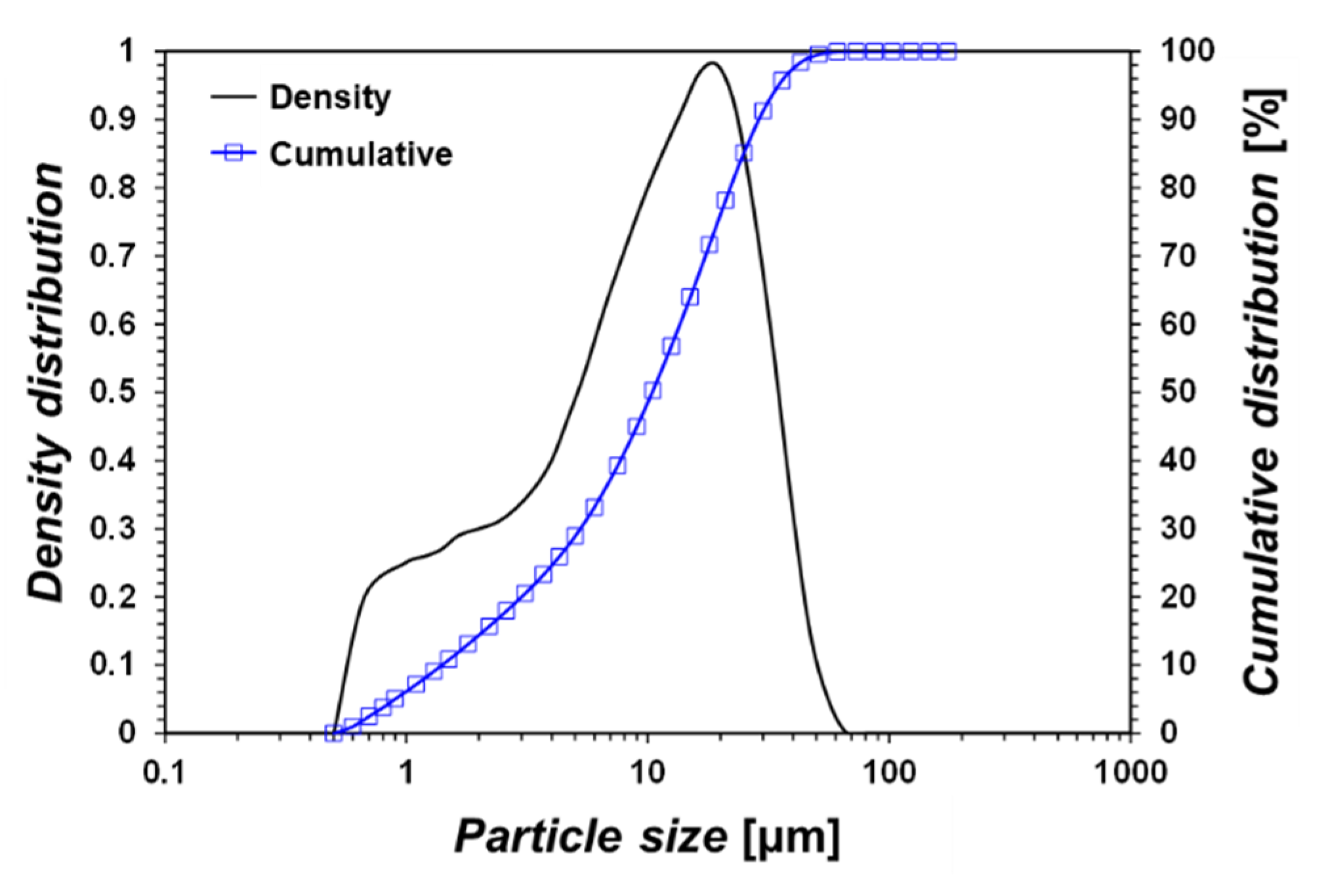
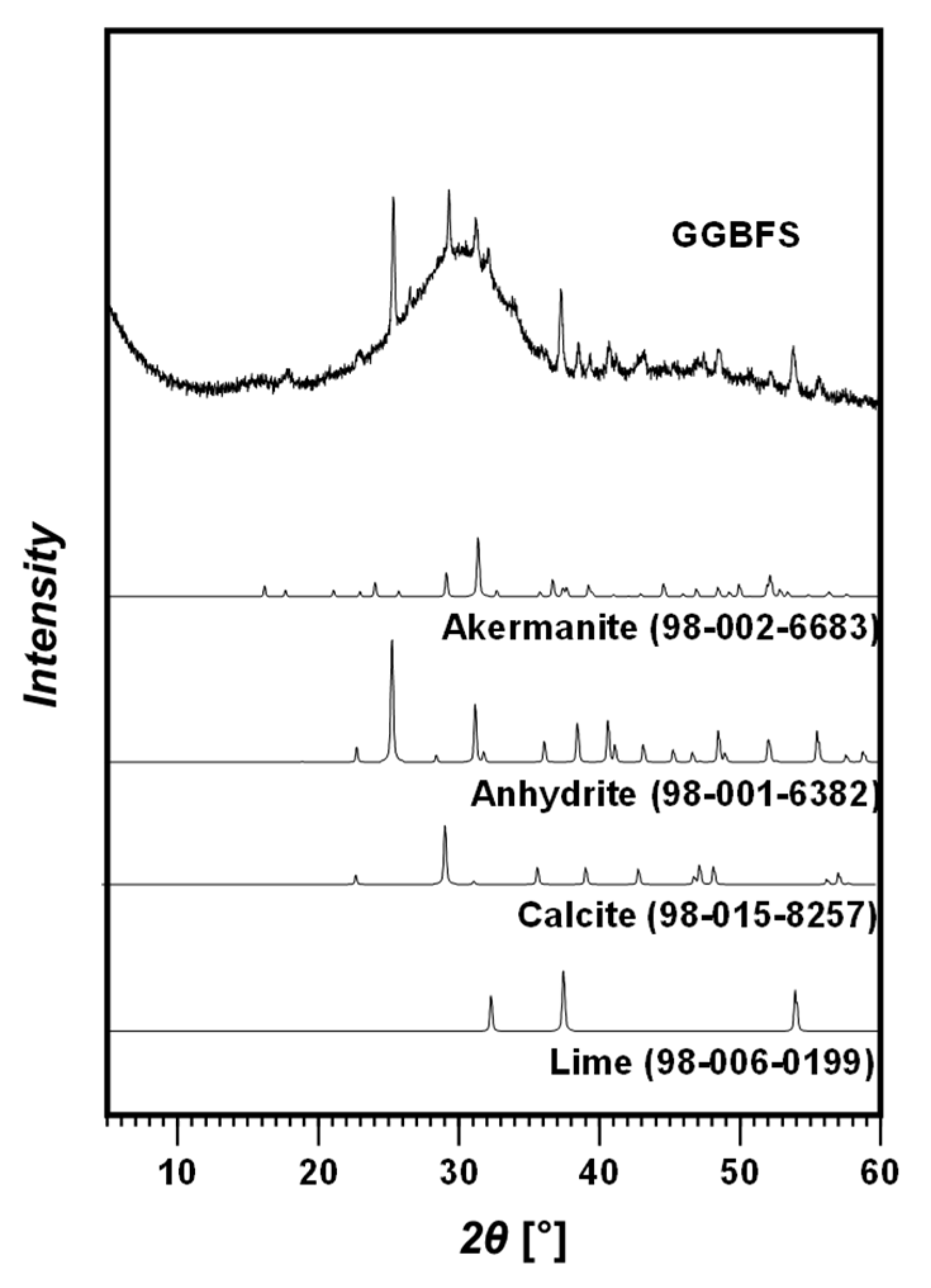
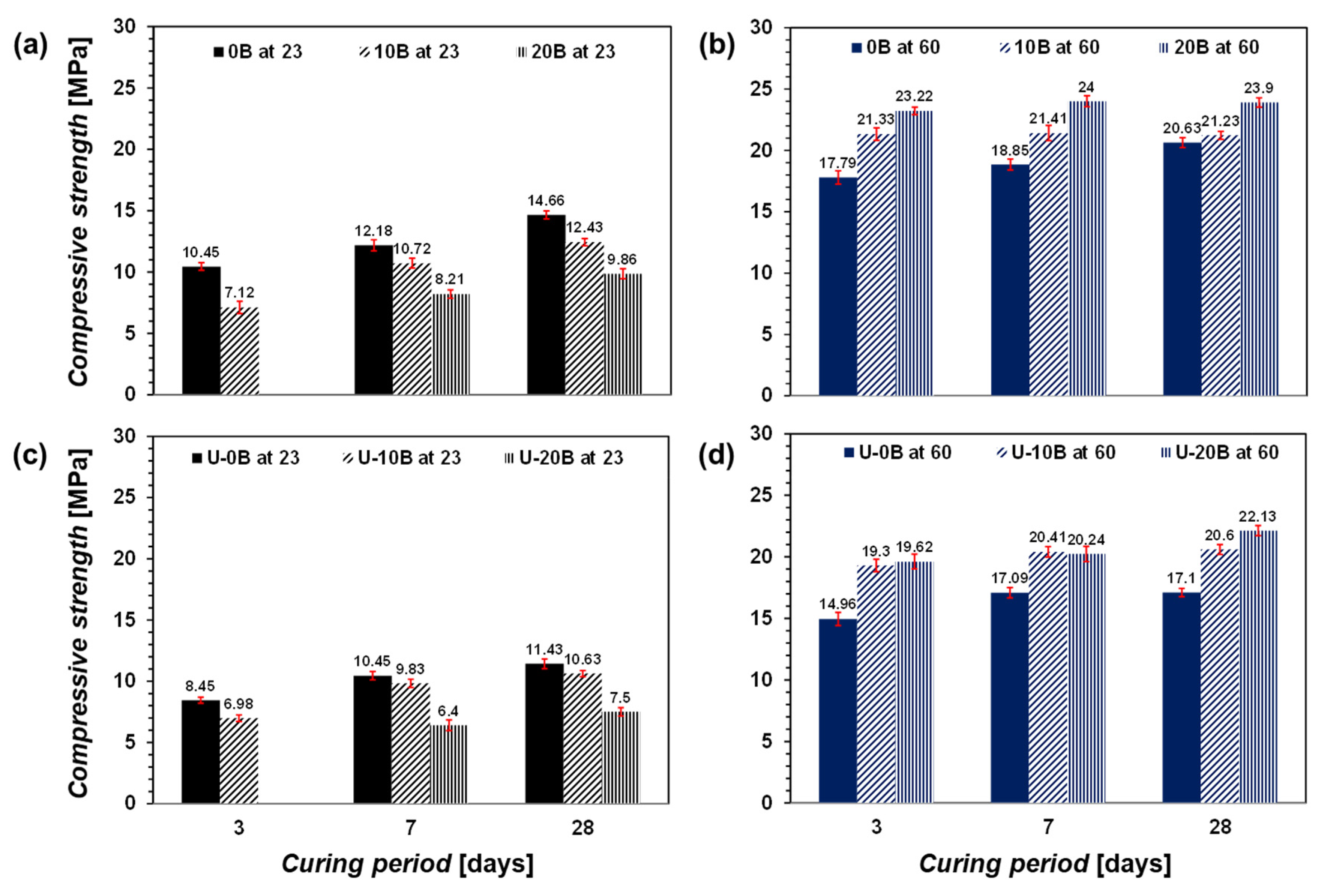
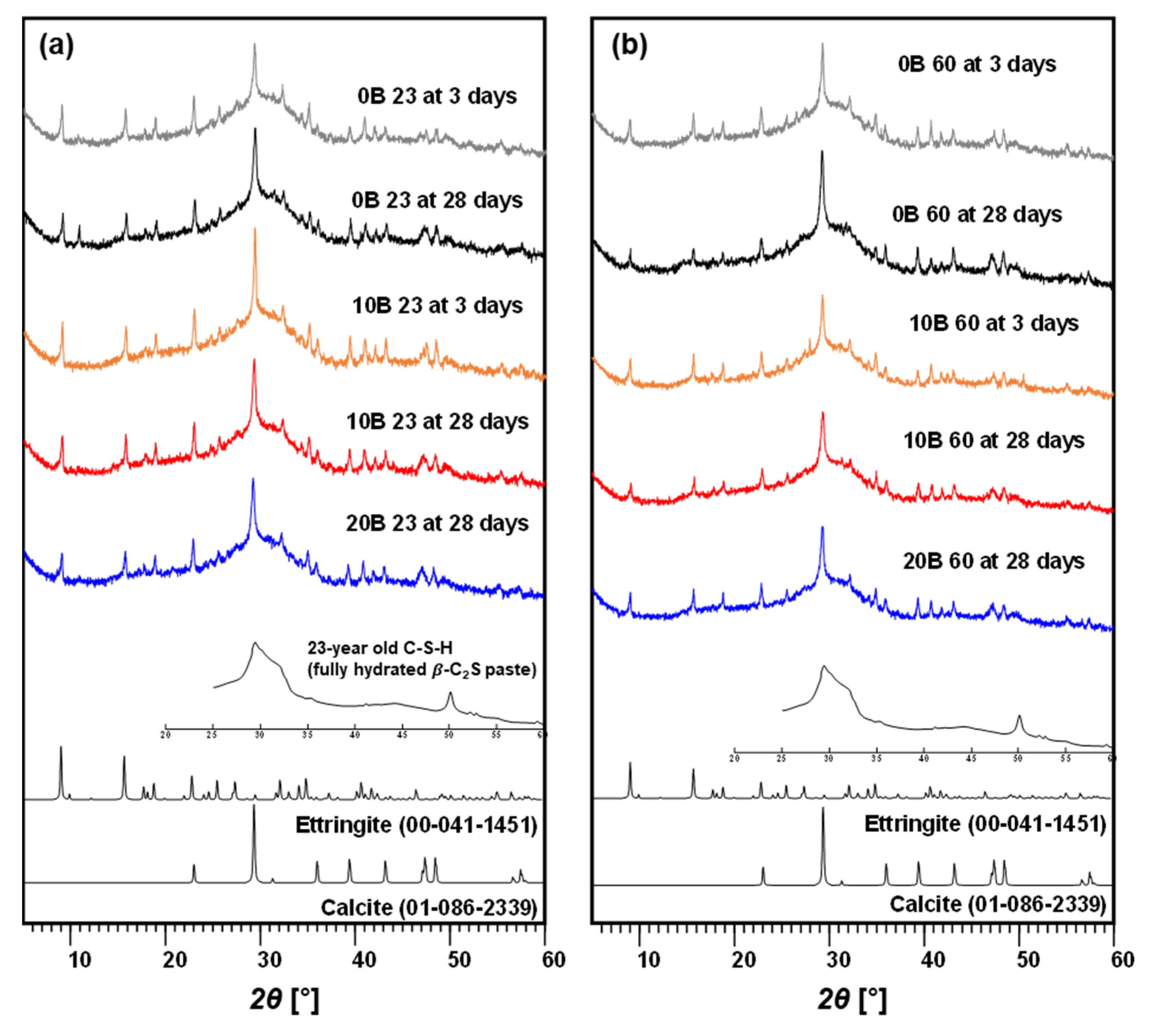
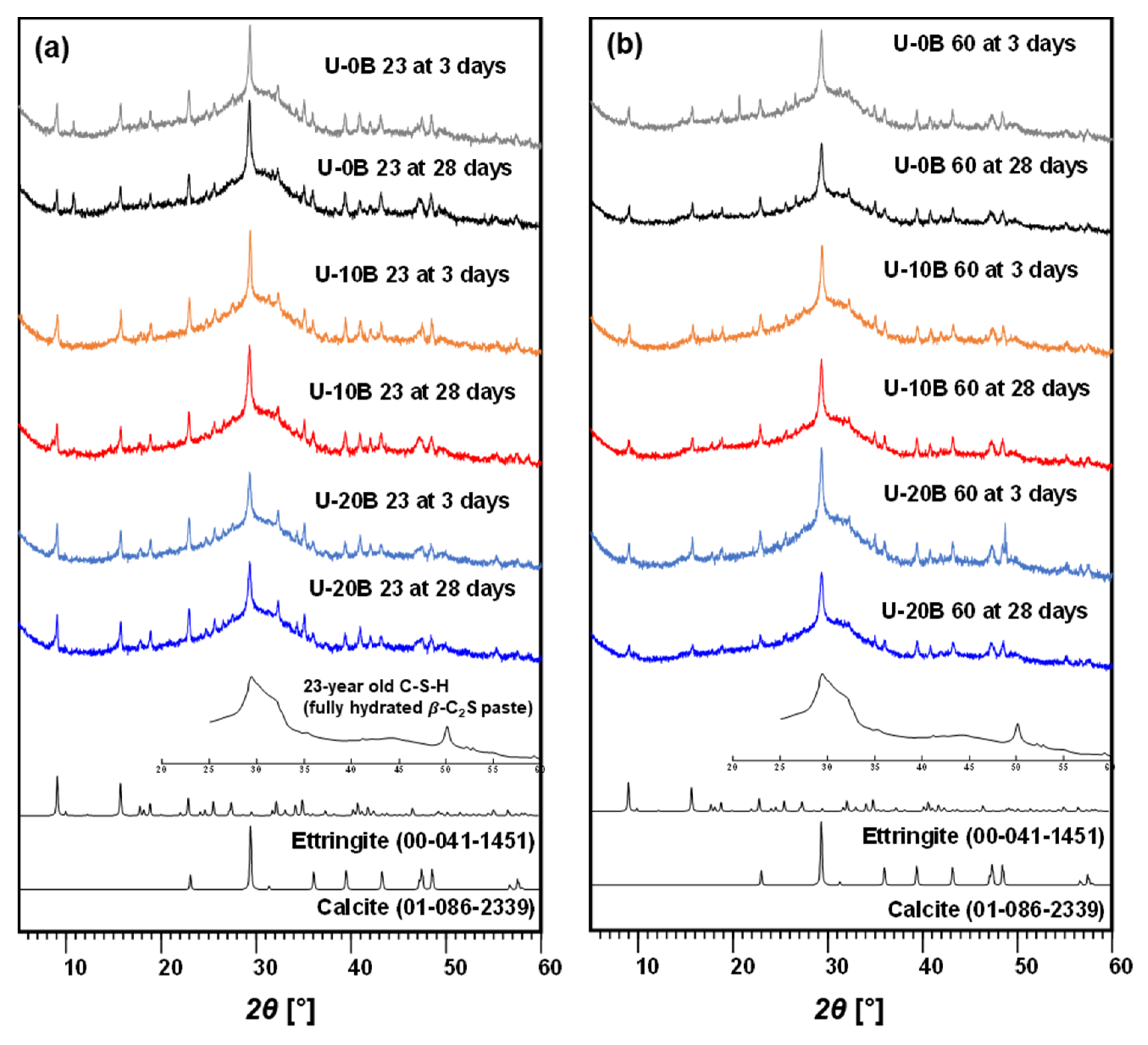
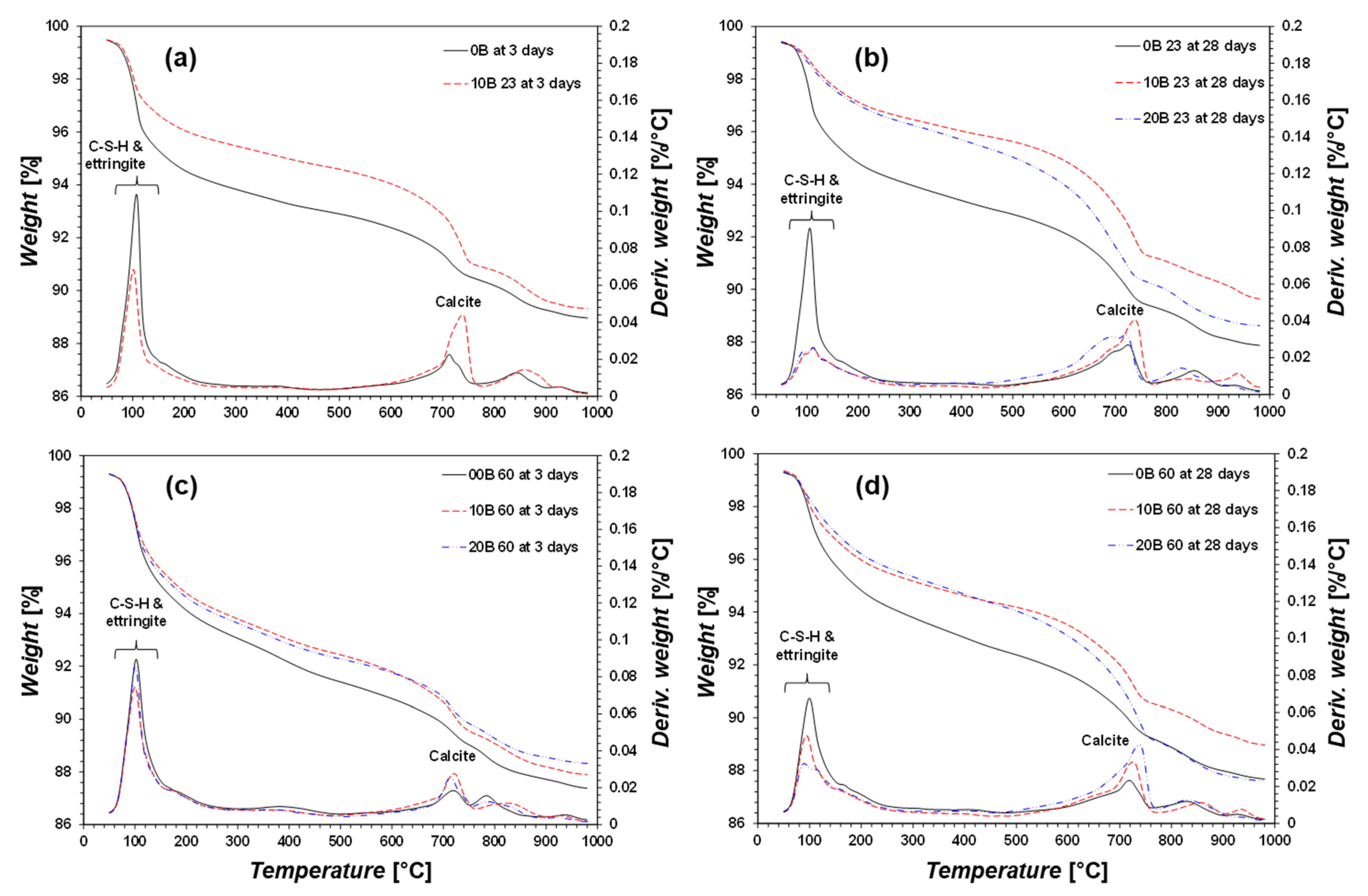




| Oxide Compositions | CaO | SiO2 | Al2O3 | F2O3 | SO3 | MgO | K2O | TiO2 | Na2O | MnO | Others |
|---|---|---|---|---|---|---|---|---|---|---|---|
| Percentage by mass (%) | 41.06 | 39.48 | 12.35 | 0.39 | 2.9 | 2.16 | 0.43 | 0.77 | 0.15 | 0.15 | 0.16 |
| Name | Sample Group | Powders | Solutions | Curing Temperature (°C) | ||
|---|---|---|---|---|---|---|
| GGBFS (% w/w) | Urea (%w/w) | Water (% per Powder) | Bacterial Suspension (% per Powder) | |||
| 0B at 23 | CON 23 | 100 | 0 | 40 | 0 | 23 |
| 10B at 23 | 30 | 10 | ||||
| 20B at 23 | 20 | 20 | ||||
| 0B at 60 | CON 60 | 100 | 0 | 40 | 0 | 60 |
| 10B at 60 | 30 | 10 | ||||
| 20B at 60 | 20 | 20 | ||||
| U-0B at 23 | U-CON 23 | 97.5 | 2.5 | 40 | 0 | 23 |
| U-10B at 23 | 30 | 10 | ||||
| U-20B at 23 | 20 | 20 | ||||
| U-0B at 60 | U-CON 60 | 97.5 | 2.5 | 40 | 0 | 60 |
| U-10B at 60 | 30 | 10 | ||||
| U-20B at 60 | 20 | 20 | ||||
| Case | Water Absorption Rate (%) | Compressive Strength (MPa) | |
|---|---|---|---|
| Standard | Type I | Less than 7% | More than 13 |
| Type II | Less than 13 | More than 8 | |
| Bacteria-activated GGBFS | 0B | 16.24 | 15.54 |
| 10B | 14.88 | 18.79 | |
| 20B | 12.08 | 20.15 | |
Publisher’s Note: MDPI stays neutral with regard to jurisdictional claims in published maps and institutional affiliations. |
© 2022 by the authors. Licensee MDPI, Basel, Switzerland. This article is an open access article distributed under the terms and conditions of the Creative Commons Attribution (CC BY) license (https://creativecommons.org/licenses/by/4.0/).
Share and Cite
Yum, W.S.; Do, J. Use of Bacteria to Activate Ground-Granulated Blast-Furnace Slag (GGBFS) as Cementless Binder. Materials 2022, 15, 3620. https://doi.org/10.3390/ma15103620
Yum WS, Do J. Use of Bacteria to Activate Ground-Granulated Blast-Furnace Slag (GGBFS) as Cementless Binder. Materials. 2022; 15(10):3620. https://doi.org/10.3390/ma15103620
Chicago/Turabian StyleYum, Woo Sung, and Jinung Do. 2022. "Use of Bacteria to Activate Ground-Granulated Blast-Furnace Slag (GGBFS) as Cementless Binder" Materials 15, no. 10: 3620. https://doi.org/10.3390/ma15103620
APA StyleYum, W. S., & Do, J. (2022). Use of Bacteria to Activate Ground-Granulated Blast-Furnace Slag (GGBFS) as Cementless Binder. Materials, 15(10), 3620. https://doi.org/10.3390/ma15103620






